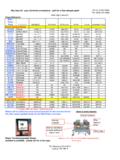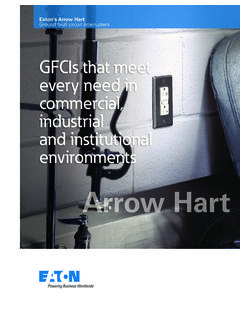Transcription of A practical guide to earth resistance testing - …
1 practical guide to earth resistance testingThe word Megger is a registered trademark Getting Down to earth 1 IntroductionNothing is quite so common or abundantly available throughout the world as the earth s soil. We are more apt to think of earth as something to be tilled for planting or to be excavated for a building foundation. Yet, it also has an electrical property -- conductivity (or low resistance ) -- that is put to practical use every day in industrial plants and speaking, earth resistance is the resistance of soil to the passage of electric current. Actually, the earth is a relatively poor conductor of electricity compared to normal conductors like copper wire.
2 But, if the area of a path for current is large enough, resistance can be quite low and the earth can be a good conductor. It is the earth s abundance and availability that make it an indispensible component of a properly functioning electrical resistance is measured in two ways for two important fields of use:1. Determining effectiveness of ground grids and connections that are used with electrical systems to protect personnel and Prospecting for good (low resistance ) ground locations, or obtaining measured resistance values that can give specific information about what lies some distance below the earth s surface (such as depth to bed rock).
3 It is not the intent of this manual to go too deeply into the theory and mathematics of the subject. As noted in the references at the end, there are many excellent books and papers that cover these. Rather, the information herein is in simple language for easy understanding by the user in years of experience in supplying instruments for the tests involved, Megger can provide advice to help you make specific tests. We would be pleased to have a representative call on you to discuss your application. 2010 Megger 2 1-866-254-0962 Getting Down to earth 3 APPENDIX I Nomograph guide to Getting Acceptable earth resistance .
4 46 APPENDIX IIClamp-On Method ..48 APPENDIX IIIA ttached Rod Technique (ART) ..54 APPENDIX IV Measurement of the resistance of Large earth -Electrode Systems: Intersect-ing Curves Method1 ..58 Test at a Large Substation ..59 General Comments ..60 APPENDIX V Slope Method ..62 APPENDIX VIFour Potential Method ..65 APPENDIX VIIStar Delta Method ..67 APPENDIX VIII Determining Touch and Step Potential ..70 APPENDIX IXGround testing Methods Chart ..72 GrouND TEsTErs AVAIlAblE from mEGGEr ..74rEfErENcEs ..76 Introduction ..1 Safety ..5sEcTIoN IEarth Resistivity ..6 How earth Resistivity is Example of Test Method ..8 Type of Soil Affects Resistivity.
5 9 Resistivity Decreases with Moisture and Dissolved Salts ..10 Effect of Temperature on earth Resistivity ..12 Seasonal Variations in earth a Good Electrode Location ..14sEcTIoN IIMeasuring earth resistance for Electrical Grounding Systems ..16 Factors That Can Change Your Minimum earth resistance ..17 Some Basic Definitions ..17 Factors Influencing Requirements for a Good Grounding System ..19 National Electrical Code Maximum Values ..20 Nature of an earth Involved in earth resistance testing ..23 Basic Test Methods for earth resistance ..26 Effects of Different Reference Probe Locations ..30 Lazy Spikes ..35 Supplementary Tests.
6 36 How to Improve earth resistance ..37sEcTIoN IIIA ccurately Measuring earth resistance for Large Ground Systems ..42 testing Challenges in Large Ground Systems ..43 Addressing the testing Challenges in Large Ground Systems ..44 TABLE OF CONTENTS 4 1-866-254-0962 Getting Down to earth 51 Four-terminal method of measuring earth resistivity ..72 earth resistivity survey of pipeline ..83 Graphs showing relation between soil and resistance ..94 Seasonal variation of earth resistance with an electrode ..135 Method of prospecting for best earth electrode location ..146 A simplified grounding system in an industrial Example of an electrical circuit with too high an earth resistance .
7 188 Typical conditions to be considered in a plant ground system ..199 Components of earth resistances in an earth electrode ..2210 Principle of an earth resistance test ..2411 Fall-of-potential or three-terminal earth resistance test ..2712 Dead earth method or two-point earth resistance Effect of C location on the earth resistance curve ..3114 Example of how C location affects the earth resistance curve ..3215 earth resistance decreases with depth of electrode in earth ..3716 Diameter of a rod has little effect on its earth resistance ..3817 Average results obtained from multiple-rod earth electrodes ..3918 Comparative resistance of multiple-rod earth electrodes.
8 3919 Trench method of soil treatment ..4120 Chemical treatment of soil ..4121 Nomograph relating the basic factors affecting earth resistance ..4722 Basic clamp-on ground testing methodology ..4923 Pole ground application ..5024 Cellular tower application ..5325 Ground resistance measurement ..5426 Leakage current measurements ..5527 Attached Rod Technique (ART) measurement ..5628 earth resistance curve applicable to systems of a large area ..5929 earth resistance curves for a substation ..6130 Intersection curves for Fig. 29 ..6131 Potential probe locations for using the slope method ..6332 Four potential method test configuration.
9 6633 Star-Delta test configuration ..6734 Making a two-point measurement ..6835 Method of use for determining touch and step potential ..71 TABLE OF FIGURESFig. PageSafetyThere is an inherent safety problem in earth resistance testing that requires care and planning by the user of the test set. The possibility exists that a fault in the power system will cause a high current to flow into the ground system while the test is in progress. This may cause unexpected high voltages to appear at the current and voltage probes and also at the terminals of the test set. This risk must be evaluated by the person responsible for the tests, taking into account the fault current available and expected step-and-touch potentials.
10 IEEE Standard 80 entitled IEEE guide for Safety in AC Substation Grounding fully covers this subject. (Other standards may prevail elsewhere in the world.)We recommend that the operator wear rubber protective gloves (ANSI/ASTM D120 or equal) while handling connections and use a rubber safety mat (ANSI/ASTM D178 or equal) while operating the test set. 6 1-866-254-0962 Getting Down to earth 7Dr. Frank Wenner of the Bureau of Standards (now NIST) developed the theory behind this test in 1915 (see reference pg. 76). He showed that, if the electrode depth (B) is kept small compared to the distance between the electrodes (A)1, the following formula applies: = 2 ARwhere is the average soil resistivity to depth A in ohm-cm, is the constant , A is the distance between the electrodes in cm, and R is the Megger earth tester reading in other words, if the distance A between the electrodes is 4 ft, you obtain the average earth resistivity to a depth of 4 ft as follows:1.







